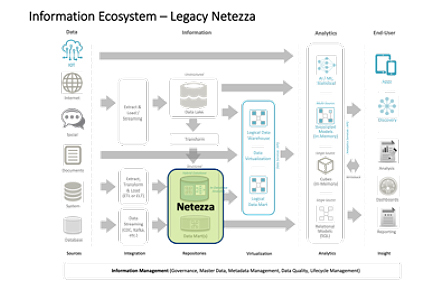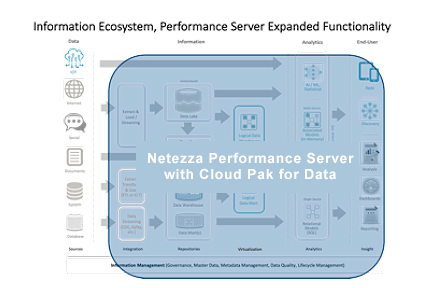Practice Director, Information & Analytics
There are some people, like me, who like to know how the story ends and thus may occasionally read the last chapter before going back and reading the rest of the book. So, I guess this is a spoiler alert. The answer to the question is, “Netezza is still alive, well, and evolving, but now is being marketed under a new name, Netezza Performance Server.”
There were some decisions about two years ago which led me to believe that Netezza was all but dead at IBM. It was quite a blow to the Netezza community, as the solution had an almost religious following. Thankfully last year, seemingly about the same time IBM acquired Red Hat, a new Netezza offering was announced: the Netezza Performance Server (NPS).
The Evolution of Netezza to Netezza Performance Server
The formal IBM name is Netezza Performance Server but for ease of conversation we will refer to it as NPS. NPS takes a large step towards making the platform more flexible and robust, while at the same time holding true to the past. It is a bundled architecture of software including the NPS / Netezza core software and broad new analytics and data processing capabilities within the IBM Cloud Pak for Data (ICP4D). The solution also includes infrastructure, adding NPS processing nodes to the ICP4D System base. The ICP4D solution includes data collection, virtualization, refinement, governance, data warehousing, and an advanced analytics platform. ICP4D is designed so that workloads do not affect the NPS processing / performance and vice versa. The ICP4D uses a containerized / hybrid cloud architecture where expanded processing needs can be delivered within the hyperconverged system, on another set of on-premise infrastructure or on the cloud.
All ICP4D components, as well as the NPS host, are containerized, running on Red Hat LINUX (RHEL) and OpenShift. OpenShift contributes a common orchestration layer and allows IBM to build more unified common functions such as administration, security and logging. NPS has all of the strengths of the legacy Netezza solutions (TwinFin, Striper, and Mako) but has removed many of the weaknesses, the largest of which was the lack of expandability without purchasing an additional appliance. The bundling of the ICP4D software and NPS achieves more than legacy Netezza could deliver. It allows end-to-end data and artificial intelligence (AI) processing capabilities in one platform. No other company or platform brings the breadth of functionality to one converged solution.
NPS and ICP4D: A Modular Solution
The IBM Cloud Pak for Data System and Performance Server are both modular in nature (IBM calls it hyperconverged) and allow for additional processing nodes to be added within the same architecture and often within the same rack. This modular architecture creates a highly tuned solution specifically aligned to each organization’s needs. The NPS solution (at this time – March 2020) is still an on-premise architecture tied to x86 hardware and leveraging the Field Programmable Gate Array (FPGA) cores as part of the NPS secret sauce, but later in 2020 there are expectations of a cloud-enabled version.
Speedy Migration and Expanded Functionality
The NPS has all of the key functions we were accustomed to including: NZ functions, INZA functions, Geospatial processing, and the core Netezza Platform Software (NPS), so migration is a snap. Mainline has customers who have migrated to the new NPS system in just a couple hours, leveraging common tools such as nz_migrate. Those leveraging User Defined Functions (UDFs) will only need to recompile, as the new NPS is 64 bit vs. the legacy 32 bit Netezzas.
The Netezza host has evolved and is now containerized, which is another step toward allowing the core functionality to truly become hybrid with components running on-premise while other workloads are shifted up to the cloud or off to other infrastructure. Performance has also received a boost through the replacement of legacy spinning disk with SSD drives. For those of you who lived through the significant disk failure rates on the TwinFin models, this will come as a welcome change for stability, not just processing speed.
In the past, the Netezza platform had a very specific and somewhat narrow role within the information ecosystem. It was a high-performance data repository / data warehouse for analytic workloads. NPS with ICP4D expands the available functionality to cover the vast majority of functions necessary to bring end-to-end information and AI value to an organization. The elegance of the solution allows for the organization to only use the solution components necessary to meet their specific value proposition or initiative. Additional functions can be seamlessly initiated over time if needs change or solution expands to reach a broader audience.
The following diagrams show the functional shift and expanded capabilities now available on NPS with ICP4D when compared to the legacy Netezza functionality. We have all seen similar information ecosystem conceptual diagrams, with data sources on the left, a flow of data from those varying sources through data processing, repositories, or virtualization and then, out to the end, consumers of the data.


Mainline Customer Success Stories
As with any newer solution in the IT market, organizations want to know if all the marketing is reality. “Does this really work?”
Mainline has been working with numerous organizations across industry segments, including:
- Retail
- Banking
- Manufacturing
- Financial Services
- Healthcare
- Research
- Higher Education
We have partnered with our customers to implement both targeted and broad-scoped use cases where NPS with ICP4D has given organizations a solution with capabilities far beyond the Netezza of old.
Use case 1: One organization offloaded a significant portion of their staging area to NoSQL solution to allow for complex Natural Language Processing (NLP) to be preprocessed before joining it back with the NPS core repository.
Use case 2: Another customer has focused on leveraging the Watson Studio components to start climbing the AI ladder and bringing additional insights to a manufacturing line, mitigating waste which was only visible once multiple processing points were combined.
Now, organizations are building upon their initial success, expanding into more complex and higher business value areas. Without NPS and ICP4D, the organization’s legacy data and systems had proven insurmountable. Mainline is in step with our customers to ensure success and the highest return on investment. In future blogs, I will share additional detail with more focus on the business transformation enabled by the NPS and ICP4D solutions.
Contact us for more information.
Get more insights from your data:

